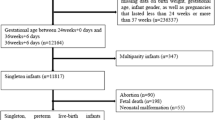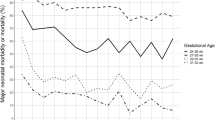Abstract
Objective To assess the association between length of prenatal participation in WIC and a marker of infant morbidity. By focusing on small for gestational age, we consider one of the possible pathways through which prenatal nutrition affects fetal growth. Design/Methods The study sample consists of 369,535 matched mother-infant pairs drawn from all singleton live births in Florida hospitals from 1996 to 2004. All subjects received WIC and Medicaid-funded prenatal services during pregnancy. We controlled for selection bias on observed variables using a generalized propensity scoring approach and performed separate analyses by gestational age category to control for simultaneity bias. Results Ten percent increase in the percent of time in WIC was associated with 2.5% decrease (95% CI: 2.1–3.0%) in the risk of a full-term an SGA infant. The risk was also significantly decreased for very preterm and late preterm infants (29–33 and 34–36 weeks gestation) but not for extremely preterm infants (23–28 weeks gestation). Conclusions The observed small negative dose response relationship between percent of pregnancy spent in WIC and fetal growth restriction implies that longer participation in the program confers a small measure of protection against delivering an SGA infant.

Similar content being viewed by others
Explore related subjects
Discover the latest articles and news from researchers in related subjects, suggested using machine learning.References
Shadish, W. R., & Reis, J. (1984). A review of studies of the effectiveness of programs to improve pregnancy outcome. Evaluation Review, 8(6), 747–776. doi:10.1177/0193841X8400800601.
Besharov, D. J., & Germanis, P. (2000). Evaluating WIC. Evaluation Review, 24(2), 123–190.
Hack, M., Klein, N. K., & Taylor, H. G. (1995). Long-term developmental outcomes of low birth weight infants. The Future of Children, 5(1), 176–196. doi:10.2307/1602514.
Whitaker, A. H., Feldman, J. F., Lorenz, J. M., Shen, S., McNicholas, F., Nieto, M., et al. (2006). Motor and cognitive outcomes in nondisabled low-birth-weight adolescents: Early determinants. Archives of Pediatrics & Adolescent Medicine, 160(10), 1040–1046. doi:10.1001/archpedi.160.10.1040.
Mitchell, E. A., Robinson, E., Clark, P. M., Becroft, D. M., Glavish, N., Pattison, N. S., et al. (2004). Maternal nutritional risk factors for small for gestational age babies in a developed country: a case-control study. Archives of Disease in Childhood. Fetal and Neonatal Edition, 89, F431–F435. doi:10.1136/adc.2003.036970.
Knudson, V. K., Orozova-Bekkevold, I. M., Mikkelsen, T. B., Wolff, S., & Olsen, S. F. (2008). Major dietary patterns in pregnancy and fetal growth. European Journal of Clinical Nutrition, 62(4), 463–470. doi:10.1038/sj.ejcn.1602745.
Moore, V. M., Davies, M. J., Willson, K. J., Worsley, A., & Robinson, J. S. (2004). Dietary composition of pregnant women is related to size of the baby at birth. The Journal of Nutrition, 134(7), 1820–1826.
Kind, K., Moore, V. M., & Davies, M. J. (2006). Diet around conception and during pregnancy—Effects on fetal and neonatal outcomes. Reproductive Biomedicine Online, 12(5), 532–541.
Osrin, D., & de L Costello, A. M. (2000). Maternal nutrition and fetal growth: Practical issues in international health. Seminars in Neonatology, 5(3), 209–219. doi:10.1053/siny.2000.0024.
McCarton, C. M., Wallace, I. F., Divon, M., & Vaughan, H. G., Jr. (1996). Cognitive and neurologic development of the premature, small for gestational age infant through age 6: Comparison by birth weight and gestational age. Pediatrics, 98(6 Pt 1), 1167–1178.
Kok, J. H., den Ouden, A. L., Verloove-Vanhorick, S. P., & Brand, R. (1998). Outcome of very preterm small for gestational age infants: The first nine years of life. British Journal of Obstetrics and Gynaecology, 105(2), 162–168.
Joyce, T., Gibson, D., & Colman, S. (2005). The changing association between prenatal participation in WIC and birth outcome in New York City. Journal of Policy Analysis and Management, 24(4), 661–685. doi:10.1002/pam.20131.
Kotelchuck, M., Schwartz, J. B., Anderka, M. T., & Finison, K. S. (1984). WIC participation and pregnancy outcomes: Massachusetts statewide evaluation project. American Journal of Public Health, 74(10), 1086–1092.
Stockbauer, J. W. (1987). WIC prenatal participation and its relation to pregnancy outcomes in Missouri: A second look. American Journal of Public Health, 77(7), 813–818.
Devaney, B., Bilheimer, L., & Schore, J. (1992). Medicaid costs and birth outcomes: The effects of prenatal WIC participation and the use of prenatal care. Journal of Policy Analysis and Management, 11(4), 573–592. doi:10.2307/3324956.
Kowaleski-Jones, L., & Duncan, G. J. (2002). Effects of participation in the WIC program on birth weight: Evidence from the National longitudinal survey of youth. American Journal of Public Health, 92(5), 799–804.
Reichman, N. E., & Teitler, J. O. (2003). Effects of psychosocial risk factors and prenatal interventions on birth weight: Evidence for New Jersey’s HealthStart program. Perspectives on Sexual and Reproductive Health, 35(3), 130–137. doi:10.1111/j.1931-2393.2003.tb00133.x.
Bitler, M. P., & Currie, J. (2005). Does WIC work? The effect of WIC on pregnancy and birth outcomes. Journal of Policy Analysis and Management, 24(1), 73–91. doi:10.1002/pam.20070.
Ludwig, J., & Miller, M. (2005). Interpreting the WIC debate. Journal of Policy Analysis and Management, 24(4), 691–701. doi:10.1002/pam.20133.
Ahluwalia, I. B., Hogan, V. K., Grummer-Strawn, L., Colville, W. R., & Peterson, A. (1998). The effect of WIC participation on small-for-gestational-age births: Michigan, 1992. American Journal of Public Health, 88(9), 1374–1377.
Lazariu-Bauer, V., Stratton, H., Pruzek, R., & Woelfel, M. L. (2004). A comparative analysis of effects of early versus late prenatal WIC participation in birth weight: NYS, 1995. Maternal and Child Health Journal, 8(2), 77–86. doi:10.1023/B:MACI.0000025730.02966.62.
Imai, K., & van Dyk, D. A. (2004). Causal inference with general treatment regimes: Generalizing the propensity score. Journal of the American Statistical Association, 99, 854–866. doi:10.1198/016214504000001187.
Alexander, G. R., Kogan, M., & Himes, J. H. (1999). 1994–1996 U.S. singleton birth weight percentiles for gestational age by race, Hispanic origin, and gender. Maternal and Child Health Journal, 3(4), 225–231. doi:10.1023/A:1022381506823.
Zou, G. (2004). A modified poisson regression approach to prospective studies with binary data. American Journal of Epidemiology, 159(7), 702–706. doi:10.1093/aje/kwh090.
Spiegelman, D., & Hertzmark, E. (2005). Easy SAS calculations for risk or prevalence ratios and differences. American Journal of Epidemiology, 162(3), 199–200. doi:10.1093/aje/kwi188.
Allen, M. C. (1984). Developmental outcome and followup of the small for gestational infant. Seminars in Perinatology, 8(2), 123–156.
Regev, R. H., Lusky, A., Dolfin, T., Litmanovitz, I., Arnon, S., & Reichman, B. (2003). Excess mortality and morbidity among small-for-gestational-age premature infants: A population-based study. The Journal of Pediatrics, 143(2), 186–191. doi:10.1067/S0022-3476(03)00181-1.
van Wassenaer, A. (2005). Neurodevelopmental consequences of being born SGA. Pediatric Endocrinology Reviews: PER, 2(3), 372–377.
Yanney, M., & Marlow, N. (2004). Paediatric consequences of fetal growth restriction. Seminars in Fetal & Neonatal Medicine, 9(5), 411–418. doi:10.1016/j.siny.2004.03.005.
Bardin, C., Piuze, G., & Papageorgiou, A. (2004). Outcome at 5 years of age of SGA and AGA infants born less than 28 weeks of gestation. Seminars in Perinatology, 28(4), 288–294. doi:10.1053/j.semperi.2004.08.006.
Eleftheriades, M., Creatsas, G., & Nicolaides, K. (2006). Fetal growth restriction and postnatal development. Annals of the New York Academy of Sciences, 1092, 319–330. doi:10.1196/annals.1365.047.
Pallotto, E. K., & Kilbride, H. W. (2006). Perinatal outcome and later implications of intrauterine growth restriction. Clinical Obstetrics and Gynecology, 49(2), 257–269. doi:10.1097/00003081-200606000-00008.
Bergvall, N., Illovo, A., Johansson, S., Tuvemo, T., & Cnattingius, S. (2006). Risks for low intellectual performance related to being born small for gestational age are modified by gestational age. Pediatrics, 117(3), e460–e467. doi:10.1542/peds.2005-0737.
El-Bastawissi, A. Y., Peters, R., Sassen, K., Bell, T., & Manolopoulos, R. (2007). Effect of the Washington special supplemental nutrition program for women, infants and children (WIC) on pregnancy outcomes. Maternal and Child Health Journal, 11(6), 611–621. doi:10.1007/s10995-007-0212-5.
Vintzileos, A. M., Anath, C. V., Smulian, J. C., Scorza, W. E., & Knuppel, R. A. (2002). The impact of prenatal care in the United States on preterm births in the presence and absence of antenatal high-risk conditions. American Journal of Obstetrics and Gynecology, 187(5), 1254–1257. doi:10.1067/mob.2002.127140.
Lydon-Rochelle, M. T., Holt, V. L., Cárdenas, V., Nelson, J. C., Easterling, T. R., Gardella, C., et al. (2005). The reporting of pre-existing maternal medical conditions and complications of pregnancy on birth certificates and in hospital discharge data. American Journal of Obstetrics and Gynecology, 193(1), 125–134. doi:10.1016/j.ajog.2005.02.096.
Northam, S., & Knapp, T. R. (2006). The reliability and validity of birth certificates. Journal of Obstetric, Gynecologic, and Neonatal Nursing, 35(1), 3–12. doi:10.1111/j.1552-6909.2006.00016.x.
Martin, J. A. (2007). United States vital statistics and the measurement of gestational age. Paediatric and Perinatal Epidemiology, 21(Suppl. 2), 13–21. doi:10.1111/j.1365-3016.2007.00857.x.
Mustafa, G., & David, R. J. (2001). Comparative accuracy of clinical estimate versus menstrual gestational age in computerized birth certificates. Public Health Reports, 116(1), 15–21. doi:10.1016/S0033-3549(04)50018-3.
Wingate, M. S., Alexander, G. R., Buekens, P., & Vahratian, A. (2007). Comparison of gestational age classifications: Date of last menstrual period vs. clinical estimate. Annals of Epidemiology, 17(6), 425–430. doi:10.1016/j.annepidem.2007.01.035.
Goldenberg, R. L., & Culhane, J. F. (2007). Low birth weight in the United States. The American Journal of Clinical Nutrition, 85(Suppl.), 584S–590S.
Kramer, M. S. (2005). Maternal nutrition and adverse pregnancy outcomes: Lessons from epidemiology. In G. Hornstra, R. Uauy, & X. Yang (Eds.), The impact of maternal nutrition on the offspring (pp. 1–15). Basel: Karger.
Metcoff, J., Costiloe, P., Crosby, W. M., Dutta, S., Sandstead, H. H., Milne, D., et al. (1985). Effect of food supplementation (WIC) during pregnancy on birth weight. The American Journal of Clinical Nutrition, 41(5), 933–947.
Joyce, T., Racine, A., & Yunzal-Butler, C. (2008). Reassessing the WIC effect: Evidence from the pregnancy nutrition surveillance system. Journal of Policy Analysis and Management, 27(2), 277–303. doi:10.1002/pam.20325.
Salihu, H. M., & Wilson, R. E. (2007). Epidemiology of prenatal smoking and perinatal outcomes. Early Human Development, 83(11), 713–720. doi:10.1016/j.earlhumdev.2007.08.002.
Rush, D., Sloan, N. L., Leighton, J., Alvir, J. M., Horvitz, D. G., Seaver, W. B., et al. (1988). The National WIC evaluation: Evaluation of the special supplemental food program for women, infants, and children. V. Longitudinal study of pregnant women. The American Journal of Clinical Nutrition, 48(2, Suppl.), 439–483.
Schieve, L. A., Cogswell, M. E., & Scanlon, K. S. (1998). Trends in pregnancy weight gain within and outside ranges recommended by the Institute of Medicine in a WIC population. Maternal and Child Health Journal, 2(2), 111–116. doi:10.1023/A:1022992823185.
Hickey, C. A., Kreauter, M., Bronstein, J., Johnson, V., McNeal, S. F., Harshbarger, D. S., et al. (1999). Low prenatal weight gain among adult WIC participants delivering term singleton infants: Variation by maternal and program participation characteristics. Maternal and Child Health Journal, 3(3), 129–140. doi:10.1023/A:1022341821346.
Scholl, T. O., & Reilly, T. (2000). Anemia, iron and pregnancy outcome. Journal of Nutrition, 130(2S Suppl.), 443S–447S.
Swensen, A. R., Harnack, L. J., & Ross, J. A. (2001). Nutritional assessment of pregnant women enrolled in the special supplemental program for women, infants, and children (WIC). Journal of the American Dietetic Association, 101(8), 903–908. doi:10.1016/S0002-8223(01)00221-8.
Acknowledgments
This study was supported in part by a grant from the National Science Foundation (#0338740), and contracts from the Florida Agency for Health Care Administration and Children’s Medical Services, Florida Department of Health. The authors wish to thank Debbie Eibeck, Karen Freeman, Meade Grigg, Jane Menges, Florida Department of Health; Ed Feaver, Charles Mahan, Chiles Center, University of South Florida; Jason Campbell, Regina Wiggins, Cliff Schmidt, Florida Agency of Health Care Administration; Debby Walters, Association of Maternal and Child Health Programs; Mario Ariet, Rajeeb Das, P.V. Rao, Michael Resnick, Maternal Child Health and Education Research and Data Center, University of Florida for their assistance, cooperation, and advice.
Human Participation Protection
This study was approved by the University of Florida Health Science Center Institutional Review Board (Project #257-2007). All personally identifiable information about subjects was removed from the linked records and a de-identified file was prepared for the researchers by the data custodians of the Maternal and Child Health and Education Research and Data Center, University of Florida.
Author information
Authors and Affiliations
Corresponding author
Rights and permissions
About this article
Cite this article
Gueorguieva, R., Morse, S.B. & Roth, J. Length of Prenatal Participation in WIC and Risk of Delivering a Small for Gestational Age Infant: Florida, 1996–2004. Matern Child Health J 13, 479–488 (2009). https://doi.org/10.1007/s10995-008-0391-8
Received:
Accepted:
Published:
Issue Date:
DOI: https://doi.org/10.1007/s10995-008-0391-8




